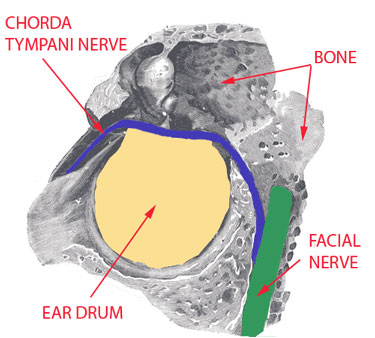I said a RED wine ...
by Andrew McNaughton
Sometimes, as the result of an earlier grommet operation, or from a congenital malformation, a cholesteatoma can form in the middle ear. Despite it's alarming sounding name, a cholesteatoma is not malignant, but it is serious. Hearing loss is highly likely, and if left untreated the mastoid bone can be eroded away. Potentially intruding upon the brain, which sits disturbingly close to the ear’s inner workings. So what’s this got to do with appreciating a good red? To remove said cholesteatoma the surgeon needs to either work down the ear canal, or hinge the ear forward to gain access. The surgeon must exercise extreme caution due to the close proximity of the facial nerve. Cut it and you’re looking, er, down in the mouth. Lurking behind the eardrum lies another nerve, the chorda tympani.

This is the one you red wine connoisseurs should be concerned about.
The chorda tympani exits the brain along with the seventh facial nerve, it then snakes its way through the middle ear, passing behind the ear drum - explaining the ‘tympani’ part of its name. Eventually it joins the lingual nerve and goes on to innervate the front two thirds of the side of the tongue. If through necessity, or an unsteady hand, an ear surgeon damages this nerve you will have a noticeable change in taste perception. Most people report an odd metallic taste. Eventually the brain readjusts and the odd taste should vanish, but inevitably some taste discernment will be lost. Your reputation for narrowing down a red to a specific Central Otago vineyard may well be over.
The odd path of the chorda tympani is explained by the interactions of the tetrapod (has, or had, four legs: amphibians, reptiles, birds and mammals) jaw and the middle ear, where the mechanics of hearing begin. As the jaw and hearing mechanisms evolved, any pre-existing structures were more or less carried along for the ride. The chorda tympani appears to have had no selective pressure acting against it as it moved. Consequently it occupies much the same unusual path in most tetrapods: a conserved characteristic.
If nothing else, this little tale of an unexpected biological twist demonstrates one thing: if this particular ‘intelligent design’ is the result of an omnipotent creator - surely he’d have seen this problem coming? Or perhaps wasn't a fan of red wine?
For anyone concerned about cholesteatoma, this page http://www.earsurgery.org/site/pages/conditions/cholesteatoma.php is informative, but if you're of a squeamish persuasion look away. The best option is to see your doctor - terrifying yourself on Google is not advised.
